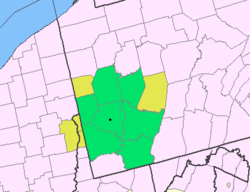| Forbes Expedition | |||||||
|---|---|---|---|---|---|---|---|
| Part of the Seven Years' War French and Indian War | |||||||
 Engraving of George Washington planting the Union Flag on the ruins of Fort Duquesne | |||||||
| |||||||
| Belligerents | |||||||
| Commanders and leaders | |||||||
| John Forbes | | ||||||
| Strength | |||||||
| 1,900 regulars 5,000 colonials | ~500 militia and natives | ||||||
| Casualties and losses | |||||||
| 350 killed wounded or captured | unknown | ||||||
The Forbes Expedition was a British military campaign to capture Fort Duquesne, led by Brigadier-General John Forbes in 1758, during the French and Indian War. While advancing to the fort, the expedition built the Forbes Road. The Treaty of Easton served to cause a loss of Native American support for the French, resulting in the French destroying the fort before the expedition could arrive on November 24.



